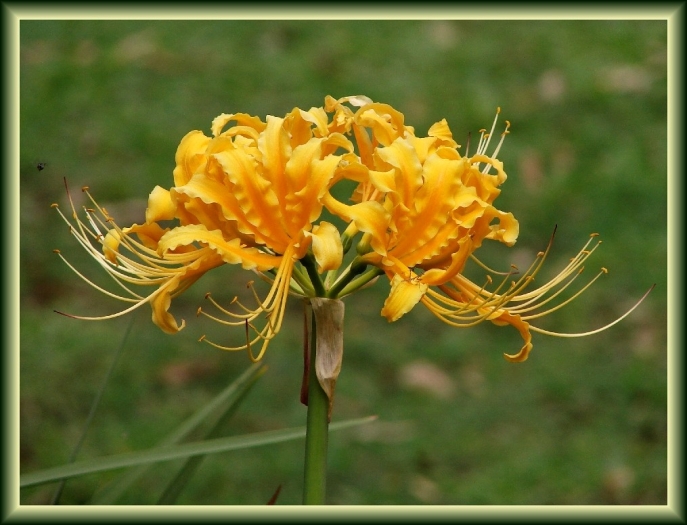Golden Spider Lily
(Lycoris aurea)
Golden Spider Lily (Lycoris aurea)
/
/

Tatters
CC BY 2.0
Image By:
Tatters
Recorded By:
Copyright:
CC BY 2.0
Copyright Notice:
Photo by: Tatters | License Type: CC BY 2.0 | License URL: https://creativecommons.org/licenses/by-sa/2.0/ | Uploader: Tatters | Publisher: Flickr |













Estimated Native Range
Summary
Lycoris aurea, commonly known as Golden Spider Lily, is a perennial bulb native to grasslands, along streams, and in lightly shaded areas of Southeast Asia, including China and Taiwan. It typically grows to a height of 1-2 feet (0.3-0.6 meters) and a width of 0.3-0.5 feet (0.09-0.2 meters). The plant features strap-shaped leaves and striking yellow flowers that bloom in late summer to early fall, with each flower displaying long, slender petals that curve outward, resembling spider legs, hence the common name. The flowers are quite showy and make a dramatic statement in the garden when they appear, often before the foliage.
Golden Spider Lily is valued for its unique and eye-catching blooms that add a tropical flair to temperate gardens. It is often used in borders, as a specimen plant, or naturalized in areas where it can spread without becoming invasive. It thrives in full sun to part shade and prefers moist, well-drained soils. While it is relatively low-maintenance, it is important to avoid waterlogged conditions, which can cause bulb rot. After flowering, the plant goes dormant, and the foliage dies back until the next growing season. It has no major pest or disease issues, but it should be protected from harsh winter conditions in cooler climates.CC BY-SA 4.0
Golden Spider Lily is valued for its unique and eye-catching blooms that add a tropical flair to temperate gardens. It is often used in borders, as a specimen plant, or naturalized in areas where it can spread without becoming invasive. It thrives in full sun to part shade and prefers moist, well-drained soils. While it is relatively low-maintenance, it is important to avoid waterlogged conditions, which can cause bulb rot. After flowering, the plant goes dormant, and the foliage dies back until the next growing season. It has no major pest or disease issues, but it should be protected from harsh winter conditions in cooler climates.CC BY-SA 4.0
Plant Description
- Plant Type: Bulb
- Height: 1-2 feet
- Width: 0.3-0.5 feet
- Growth Rate: Moderate
- Flower Color: Yellow
- Flowering Season: Summer, Fall
- Leaf Retention: Deciduous
Growth Requirements
- Sun: Full Sun, Part Shade
- Water: Medium
- Drainage: Medium, Fast
Common Uses
Bee Garden, Bird Garden, Border Plant, Butterfly Garden, Deer Resistant, Drought Tolerant, Fragrant, Hummingbird Garden, Low Maintenance, Potted Plant, Rabbit Resistant, Rock Garden, Showy Flowers
Natural Habitat
native to grasslands, along streams, and in lightly shaded areas of Southeast Asia, including China and Taiwan
Other Names
Common Names: Golden Hurricane-Lily, Golden Spider-Lily, 龍爪花;金花石蒜
Scientific Names: , Lycoris aurea, Lycoris africana, Amaryllis aurea, Amaryllis platypetala, Amaryllis africana, Hippeastrum platypetalum, Lycoris aurea subsp. angustitepala, Lycoris aurea subsp. surgens, Lycoris aurea var. angustitepala
GBIF Accepted Name: Lycoris aurea (L’Hér.) Herb.